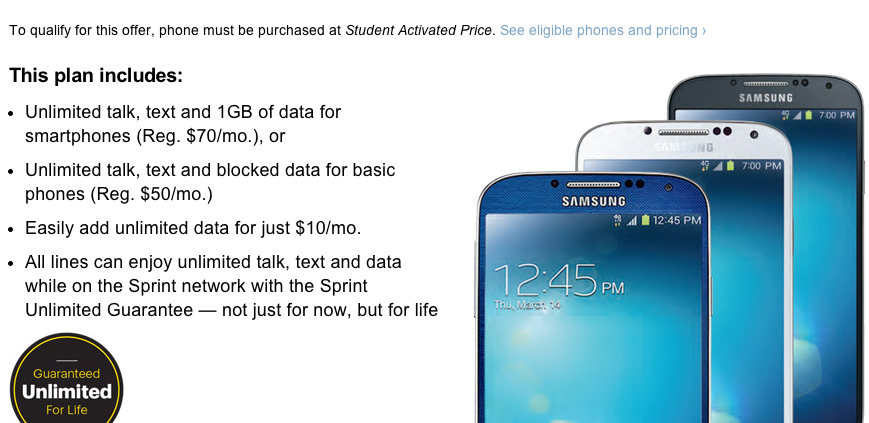Sprint & Best Buy Go After Students With 1-Year Free Service Deal. Is It Worth It?
 Brands love hooking in high school and college students because they’re getting those young consumers at a critical point in their lives, where they are making some shopping decisions that will last for a long time. High school and college students love free stuff because it’s free. Put those two ideas in a cocktail shaker, stir for a minute and you’ve got the new offer from Sprint and Best Buy that gives a free year of Sprint service to students who get their phones (at a price) from Best Buy.
Brands love hooking in high school and college students because they’re getting those young consumers at a critical point in their lives, where they are making some shopping decisions that will last for a long time. High school and college students love free stuff because it’s free. Put those two ideas in a cocktail shaker, stir for a minute and you’ve got the new offer from Sprint and Best Buy that gives a free year of Sprint service to students who get their phones (at a price) from Best Buy.
But before you and all your buddies from Big State U. go road-tripping to the nearest Best Buy, you should be aware of the fine print.
NOT UNLIMITED DATA
While the “Unlimited, My Way Student” program has that lovely word “unlimited” in it, and even though Sprint makes all sorts of to-do in its advertising about its unlimited data plans, this plan actually caps monthly data usage at 1GB, with an overage fee of $.015/MB. Sprint says students can remove that cap by paying $10/month. That’s still a huge savings compared to the comparable $80/month Sprint plan.
PAYING FULL PRICE FOR THE PHONE… NOW
Saving $70/month on service means you’ll eventually save $840 over the course of the 12 months, but you’ve got to spend a good chunk of that money right away at Best Buy when you get your phone. Here is the list of phones being included in the plan and their prices.
At the bottom end of the spectrum is the Kyocera Kona, which Sprint gives away for free to new and renewing customers but is charging $250 here. On the other end is the iPhone 5S with 64GB of storage. Paying $900 upfront for this phone will wipe away all the savings from the free service and cost you about $60 on top of that. Sprint customers can currently get this phone for $299 with a two-year contract.
The average price of the phones on the list is $546.40, with the median being $600. Only five of the 25 phones listed are being sold for less than $400.
When you’re year of free service is done, you go from paying nothing (or $10) to paying $70 (or $80) for the remaining 12 months of the contract (Correction: The subscriber is switched to the regular Sprint plan, but cancel without penalty after the initial 12 months).
By our math, a student customer who spends $600 on the iPhone 5C and gets the year of free service will eventually still save $240 over the student who gets the same phone for free but pays full price for their service in a two-year contract. The question to ask is whether it’s better to spend the money upfront to see those long-term savings, or if it’s better to pay slightly more over time but never be hit with a huge bill for your wireless device.
ACTIVATION AIN’T FREE BUDDY
Only the monthly service is free for a year, meaning you’re still slapped with a $36 activation fee. You’ll also have to pay any applicable taxes and surcharges.
NO IN-PERSON VERIFICATION
While you buy the phone at Best Buy stores (and not on BestBuy.com), our reading of this Sprint FAQ is that you have to verify your student status online or by fax by sending Sprint a document like a report card, student ID or such. This isn’t that huge of a problem, but if you somehow forget — highly possible when dealing with students — to verify within 14 days of the purchase, you get hit with the $70/month plan (or $80/month if you’ve opted for the unlimited data plan).
TELL YOUR FRIENDS (BUT PROBABLY DON’T)
This part initially sounds great: For every person you refer to the program, you get an additional 12 months of free service. BUT — and this is a but so big it deserves a Sir Mix-A-Lot tribute song — both lines need to be on the same account. So this is fine for student siblings whose parents are footing the bill, but we could easily see a group of college kids trying to figure out how to get years of free service by putting as many people as possible on the same account. That won’t end well.
One thing that will curb this sort of chicanery is the time limit, as the deal is only being offered through Jan. 4, 2014.
[via The Verge]
Want more consumer news? Visit our parent organization, Consumer Reports, for the latest on scams, recalls, and other consumer issues.

